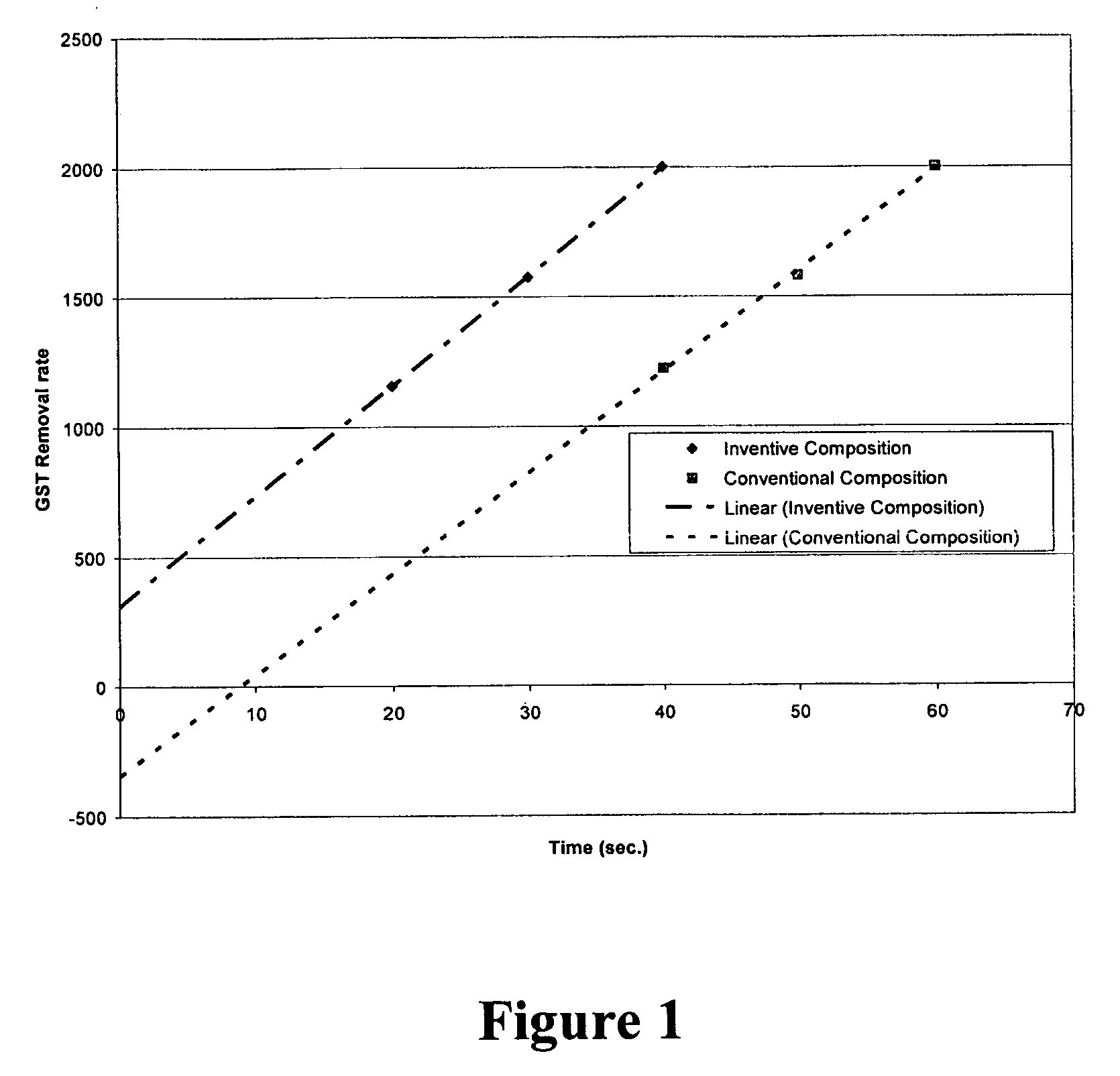Compositions and methods for CMP of phase change alloys
a technology of phase change alloys and compositions, applied in the direction of polishing compositions with abrasives, other chemical processes, chemistry apparatuses and processes, etc., can solve the problems of limited re-programmability, limited chip density, slow programing speed,
- Summary
- Abstract
- Description
- Claims
- Application Information
AI Technical Summary
Benefits of technology
Problems solved by technology
Method used
Image
Examples
example 1
[0027]This example illustrates the performance of a conventional CMP composition for removal of a GST film from a substrate, compared to a composition of the invention.
[0028]Wafers having a GST film surface (200 mm TEOS wafers having 2000 Å thickness of a Ge2Sb2Te5 film on the surface thereof) were polished on an IPEC 472 polisher having an IC1000 polishing pad, with a platen speed of about 90 rpm, a carrier speed of about 87 rpm, a down pressure of about 3 psi, and a slurry flow rate of 200 mL / minute. The conventional CMP compositions evaluated had the formulations shown in Table 1, along with the GST removal rates obtained therefrom. Removal of GST by conventional CMP composition (0.5 percent by weight fumed silica and about 3 percent by weight hydrogen peroxide) was uneven, particularly when close to clearing (i.e., removal of the whole layer) and resulted in a scratched GST surface after removal of about 1000 Å. In contrast, a CMP composition of the invention (Example 1D) afford...
example 2
[0029]This example illustrates the ability of CMP compositions containing a chelating agent to effectively remove a GST film.
[0030]Wafers having a GST film surface (200 mm TEOS wafers having 2000 Å thickness of a Ge2Sb2Te5 film on the surface thereof) were polished on a Mirra polisher having an IC1010 polishing pad, with a platen speed of about 90 rpm, a carrier speed of about 87 rpm, a down pressure of about 3 psi, and a slurry flow rate of 200 mL / minute. The CMP compositions evaluated included either about 1 percent by weight malonic acid or about 1 percent by weight succinic acid as the chelating agent, about three percent by weight of hydrogen peroxide, and either 1 percent by weight or 3 percent by weight of colloidal silica having an average particle size of about 70 nm, in water at pH 3. The results (GST removal rates) are shown in Table 2. All of the formulations provided relatively even and scratch-free removal of GST.
TABLE 2CMP Formulations Including a Chelating Agent.Exam...
example 3
[0031]This example illustrates the ability of CMP compositions of the invention containing a chelating agent, an oxidizing agent, and an abrasive in an amount of not more than about 3 percent by weight to effectively remove a GST film.
[0032]Wafers having a GST film surface (200 mm TEOS wafers having 2000 Å thickness of a Ge2Sb2Te5 film on the surface thereof) were polished on an IPEC 472 polisher having an IC1000 polishing pad, with a platen speed of about 90 rpm, a carrier speed of about 87 rpm, a down pressure of about 3 psi, and a slurry flow rate of 200 mL / minute. The CMP compositions evaluated included either about 1 percent by weight malonic acid or about 1 percent by weight oxalic acid as the chelating agent, about three percent by weight of hydrogen peroxide, and either 1 percent by weight or 0.2 percent by weight of colloidal silica having an average particle size of about 20 nm or 80 nm, in water at pH 3. The results (GST removal rates) are shown in Table 3. An examination...
PUM
| Property | Measurement | Unit |
|---|---|---|
| mean particle size | aaaaa | aaaaa |
| mean particle size | aaaaa | aaaaa |
| thickness | aaaaa | aaaaa |
Abstract
Description
Claims
Application Information
 Login to View More
Login to View More - R&D
- Intellectual Property
- Life Sciences
- Materials
- Tech Scout
- Unparalleled Data Quality
- Higher Quality Content
- 60% Fewer Hallucinations
Browse by: Latest US Patents, China's latest patents, Technical Efficacy Thesaurus, Application Domain, Technology Topic, Popular Technical Reports.
© 2025 PatSnap. All rights reserved.Legal|Privacy policy|Modern Slavery Act Transparency Statement|Sitemap|About US| Contact US: help@patsnap.com

